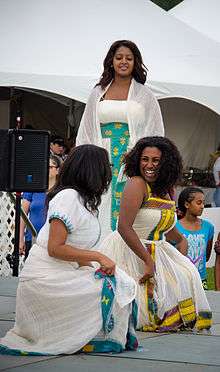Tigrinyas
| ከበሳ | |
|---|---|
 Tigrinya women performing a traditional dance | |
| Regions with significant populations | |
| Southern, Central, Northern Red Sea and Anseba Regions | |
| Languages | |
| Tigrinya | |
| Religion | |
| Predominantly Christianity (Eritrean Orthodox Church, Catholicism, Protestantism); also Islam | |
| Related ethnic groups | |
| Agaw · Amhara · Beja people · Beta Israel · Bilen people · Gurage · Harari · Oromo · Saho · Somali · Tigrayans · Tigre[1] |
The Tigrinyas (also referred to as Biher Tigrinya, Kebessa, and Biher-Tigrinya) are an ethnic group inhabiting central Eritrea, an area spanning the Southern and Central, as well as the Northern Red Sea and Anseba Regions - mostly part of the Eritrean highlands (hence the name Kebessa meaning 'highland' in the local language). Linguistically, Tigrinyas are related to the Tigrayans of Ethiopia, both of whom speak Tigrinya, an Ethiopian Semitic language belonging to the Afroasiatic family.[2] Most are followers of the Eritrean Orthodox Tewahedo Church.[3] They make up roughly 55% of Eritrea's population[4] numbering 3.4 million people. They are not to be confused with the Tigre people who speak Tigre, a closely related Afroasiatic language.
Culture and Society
Religion
Tigrinyas predominately belong to the Eritrean Orthodox Tewahedo Church. However, a minority are members of the Catholic Church or to P'ent'ay churches, the former having been introduced by the Italians near the end of the 19th century. There also is a Muslim minority.[5]

Languages
The majority of Tigrinyas speak the northern dialect of Tigrinya as their first language.[2] A minority in the Anseba and Northern Red Sea Regions speak Tigre as a second language.
Notable people of Tigrinya origin
- Isaias Afwerki - President of Eritrea[6]
- Yemane Baria - Eritrean revolutionary national singer[7]
- Bahta Hagos - 19th century Dejazmach of Akkele Guzay[8]
- Helen Meles - Eritrean popular singer[9]
- Woldemichael Solomon - 19th century governor of Medri Bahri and Hamasien[10]
See also
References
- ↑ Joireman, Sandra F. (1997). Institutional Change in the Horn of Africa: The Allocation of Property Rights and Implications for Development. Universal-Publishers. p. 1. ISBN 1581120001.
- 1 2 Irene Thompson (February 7, 2016). "Tigrigna". aboutworldlanguages.com. Retrieved 7 June 2016.
- ↑ Tesfagiorgis G., Mussie (2011). Eritrea. Greenwood Publisihing Group. p. 337. ISBN 978-1-59884-231-9.
- ↑ "The World Factbook". www.cia.gov. Retrieved 28 April 2016.
- ↑ Tesfagiorgis, Mussie (2010). Eritrea. ABC-CLIO. p. 217. ISBN 978-1-59884-232-6.
- ↑ Africa Insight, Volumes 23-24. Africa Institute. 1993. p. 187. Retrieved 31 August 2016.
- ↑ Eritrea By Mussie Tesfagiorgis G. Ph.D.
- ↑ Blood, Land, and Sex: Legal and Political Pluralism in Eritrea
- ↑ Tesfagiorgis G., Mussie (2010). Eritrea. ABC-CLIO. p. 281. ISBN 1598842315. Retrieved 11 November 2014.
- ↑ Edward Denison, Edward Paice (2007). Eritrea: The Bradt Travel Guide. Bradt Travel Guides. p. 82. ISBN 1841621714. Retrieved 3 September 2016.